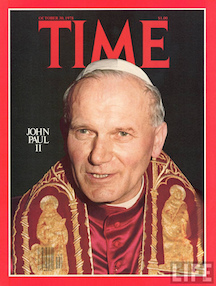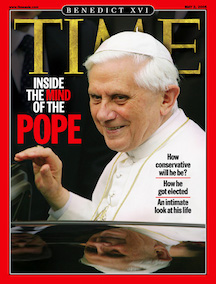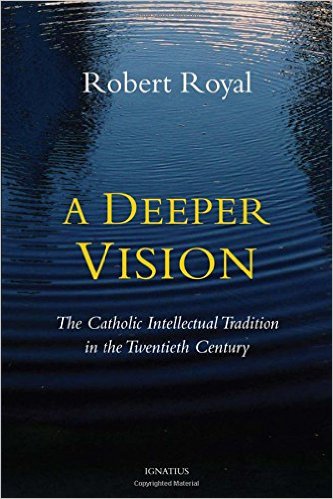When Waves Break Over the Barque of Peter
Those who love the Church and have followed the papacies of Paul VI, St. John Paul II, and Benedict XVI with dedication and enthusiasm, are in a state of alarm. Suddenly, amid much sweet-talk, the clarity of Catholic teaching seems to be being disassembled. What is happening? And why must we hold on tight, without fear?
The lucidity and truth that graced the second half of the 20th Century through the teachings of these great Pontiffs, touching untold millions of Catholics and non-Catholics alike, awakened a love and respect for the Roman Catholic Church which had been largely dormant after World War II and had then been severely questioned in the 1960s and 1970s.
A great revolt engulfed Western culture. Doctrine was thrown out; family was subverted; tradition was turned upside down: rather than representing the slowly accumulated wisdom of centuries, it was made to seem ridiculous; morality became “intolerance,” “fanaticism,” pointless self-limitation.

As a result, the 1980s witnessed the beginning of societal and legal changes that were confusing and distressing to believers of all faiths. In the Catholic Church, the hierarchy – educated in an earlier time – kept up appearances of orthodoxy, but dissent was tolerated, and (for those of us who were young at the time) it was clear there were two kinds of priests.
Faithful priests and bishops accepted Paul VI’s prophetic 1968 encyclical, Humanae vitae, even if they didn’t fully understand it at the time. By contrast, those formed in 1960s permissiveness and relativism, contemptuously disregarded it. Pope Paul VI rightly remarked that “the smoke of Satan has infiltrated the Church.” It was a very tough time for young couples, and for parents who increasingly saw their young adopting a contraceptive sexual morality.
Soft teaching in the seminaries led many future priests to believe that “authority” has no right to impose standards or morality; and it also produced the homosexual priests who committed dreadful acts of pederasty. Efforts made to hide this shameful reality as an “illness” (pedophilia) were belied by the fact that the vast majority of cases involved adolescent boys. Some bishops, cowardly or worse, protected those priests, as we know.
Why was this tolerated?
It was tolerated because the generation of the 1960s and 1970s, by then in positions of authority, was averse to the “imposition” of morals or discipline. It was permissive by conviction.
The surprising and captivating arrival on the scene of Karol Wojtyla, St. John Paul II, with his riveting presentation of the time-honored truths of the Gospel and his true aggiornamento was destabilizing for the 1960s. But it impassioned and stimulated the following generation, and faithful priests, religious, and laity everywhere.

He came with experience of war, Nazism, Communism, and wickedness of every kind and knew the logic of the Gospel, and the Good News about the human person and salvation. Further, his knowledge had been honed among young people and couples, among those who suffered, heroes and ordinary lay people. He electrified the world with inspiring explanations of how we should live. He did not bring easy solutions, but happy ones. He gave us comprehensible explanations of who we are and how we are to live the Gospel message in our day.
When Benedict XVI succeeded John Paul, he turned his attention to the vice that had infiltrated the higher echelons of the Church. He disciplined and exiled Father Marcial Maciel and initiated an investigation into the widespread rumors of homosexuality and financial improprieties within the Curia. We do not know the contents of the report that was produced; but we do know that it caused great alarm within some high circles in Rome.
The three decades of brilliant worldwide evangelization by Popes John Paul II and Benedict XVI was enormously successful among the laity and a whole new generation of priests, willing and able to teach true Catholic faith and morals.
But many among those of the generation before were not happy to see conviction and firmness in the faith blossoming again. A number of bishops and cardinals in the developed world felt quite uncomfortable as their easy-going, permissive ways clashed with this new vigor. Some of these by now very powerful old prelates, we now know, decided to “save” the Church from what they evidently considered old-fashioned and ‘rigid’ teachings.

We are told they founded the “St. Gallen Club” or “mafia” in order to lay plans to wrench the Barque of Peter around to a different course. Taking advantage of the tolerance of the former popes, who never humiliated them for their doctrinal laxity, this St. Gallen club was successful in promoting a candidate for pope. Jorge Bergoglio was elected.
The generation of the 1970s is now in power in the Church. In business and politics, that generation is mainly retired. Many were broken by the tragedies of drugs and sex that destroyed their own children. But in the Church, many are still there – and are now powerful.
The outrageous homoerotic mural commissioned by Archbishop Vincenzo Paglia for his cathedral in Terni did not prevent his being put in charge of, and radically changing, the sections of the Vatican pertaining to Life and Family: the Pontifical Council for Family, the Pontifical Academy for Life and the John Paul II Institutes for Family Studies.
Archbishop Paglia (surely soon to be a Cardinal) also commissioned a “Sex Education” program, in five languages, which contradicts important principles of Church teaching on sexual education.
And so we see a great divide today in the Church. The rank and file of practicing Catholics are more motivated than ever to live and teach real Catholic social and moral doctrine. But they see that prelates formed in permissiveness and relativity being promoted. Even scandals involving drugs and sex within the Vatican do not seem to slow the repeal and replacement of the traditional categories of morality and gender, so beautifully confirmed by our recent great popes.
We are headed for very rough waters and we must not lose heart. Our Lord is alive and we must be faithful to Him and His teaching during this time of trial. Young priests and laity, and the many faithful movements, must hold firmly to the Truth, united in prayer and action until this storm is calmed. Jesus, I trust in You
The lucidity and truth that graced the second half of the 20th Century through the teachings of these great Pontiffs, touching untold millions of Catholics and non-Catholics alike, awakened a love and respect for the Roman Catholic Church which had been largely dormant after World War II and had then been severely questioned in the 1960s and 1970s.
A great revolt engulfed Western culture. Doctrine was thrown out; family was subverted; tradition was turned upside down: rather than representing the slowly accumulated wisdom of centuries, it was made to seem ridiculous; morality became “intolerance,” “fanaticism,” pointless self-limitation.

As a result, the 1980s witnessed the beginning of societal and legal changes that were confusing and distressing to believers of all faiths. In the Catholic Church, the hierarchy – educated in an earlier time – kept up appearances of orthodoxy, but dissent was tolerated, and (for those of us who were young at the time) it was clear there were two kinds of priests.
Faithful priests and bishops accepted Paul VI’s prophetic 1968 encyclical, Humanae vitae, even if they didn’t fully understand it at the time. By contrast, those formed in 1960s permissiveness and relativism, contemptuously disregarded it. Pope Paul VI rightly remarked that “the smoke of Satan has infiltrated the Church.” It was a very tough time for young couples, and for parents who increasingly saw their young adopting a contraceptive sexual morality.
Soft teaching in the seminaries led many future priests to believe that “authority” has no right to impose standards or morality; and it also produced the homosexual priests who committed dreadful acts of pederasty. Efforts made to hide this shameful reality as an “illness” (pedophilia) were belied by the fact that the vast majority of cases involved adolescent boys. Some bishops, cowardly or worse, protected those priests, as we know.
Why was this tolerated?
It was tolerated because the generation of the 1960s and 1970s, by then in positions of authority, was averse to the “imposition” of morals or discipline. It was permissive by conviction.
The surprising and captivating arrival on the scene of Karol Wojtyla, St. John Paul II, with his riveting presentation of the time-honored truths of the Gospel and his true aggiornamento was destabilizing for the 1960s. But it impassioned and stimulated the following generation, and faithful priests, religious, and laity everywhere.

He came with experience of war, Nazism, Communism, and wickedness of every kind and knew the logic of the Gospel, and the Good News about the human person and salvation. Further, his knowledge had been honed among young people and couples, among those who suffered, heroes and ordinary lay people. He electrified the world with inspiring explanations of how we should live. He did not bring easy solutions, but happy ones. He gave us comprehensible explanations of who we are and how we are to live the Gospel message in our day.
When Benedict XVI succeeded John Paul, he turned his attention to the vice that had infiltrated the higher echelons of the Church. He disciplined and exiled Father Marcial Maciel and initiated an investigation into the widespread rumors of homosexuality and financial improprieties within the Curia. We do not know the contents of the report that was produced; but we do know that it caused great alarm within some high circles in Rome.
The three decades of brilliant worldwide evangelization by Popes John Paul II and Benedict XVI was enormously successful among the laity and a whole new generation of priests, willing and able to teach true Catholic faith and morals.
But many among those of the generation before were not happy to see conviction and firmness in the faith blossoming again. A number of bishops and cardinals in the developed world felt quite uncomfortable as their easy-going, permissive ways clashed with this new vigor. Some of these by now very powerful old prelates, we now know, decided to “save” the Church from what they evidently considered old-fashioned and ‘rigid’ teachings.

We are told they founded the “St. Gallen Club” or “mafia” in order to lay plans to wrench the Barque of Peter around to a different course. Taking advantage of the tolerance of the former popes, who never humiliated them for their doctrinal laxity, this St. Gallen club was successful in promoting a candidate for pope. Jorge Bergoglio was elected.
The generation of the 1970s is now in power in the Church. In business and politics, that generation is mainly retired. Many were broken by the tragedies of drugs and sex that destroyed their own children. But in the Church, many are still there – and are now powerful.
The outrageous homoerotic mural commissioned by Archbishop Vincenzo Paglia for his cathedral in Terni did not prevent his being put in charge of, and radically changing, the sections of the Vatican pertaining to Life and Family: the Pontifical Council for Family, the Pontifical Academy for Life and the John Paul II Institutes for Family Studies.
Archbishop Paglia (surely soon to be a Cardinal) also commissioned a “Sex Education” program, in five languages, which contradicts important principles of Church teaching on sexual education.
And so we see a great divide today in the Church. The rank and file of practicing Catholics are more motivated than ever to live and teach real Catholic social and moral doctrine. But they see that prelates formed in permissiveness and relativity being promoted. Even scandals involving drugs and sex within the Vatican do not seem to slow the repeal and replacement of the traditional categories of morality and gender, so beautifully confirmed by our recent great popes.
We are headed for very rough waters and we must not lose heart. Our Lord is alive and we must be faithful to Him and His teaching during this time of trial. Young priests and laity, and the many faithful movements, must hold firmly to the Truth, united in prayer and action until this storm is calmed. Jesus, I trust in You

No comments:
Post a Comment